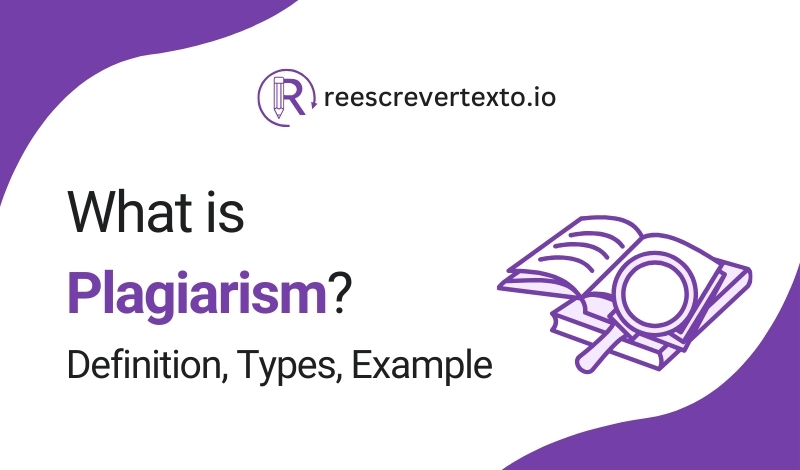
What is Plagiarism? Definition, Types, Example
Many people think plagiarism only means copying someone's text, but that is not true. Even paraphrasing someone's idea without proper credit also counts as plagiarism. It could be either intentional or accidental. Plagiarism can affect your credibility and trustworthiness.
Therefore, when you give credit, you show respect for others' work and build your reputation as an honest person. You should understand plagiarism to protect yourself from serious consequences in academic and professional life.
What does plagiarism mean? It simply means using someone else's work without permission. Plagiarism examples show that this act can affect your credibility and trustworthiness. This blog will explain everything in detail, including the types of plagiarism and how to avoid them.
What is plagiarism?
Plagiarism occurs when you copy another person’s words, ideas and designs and present them as your own without giving them proper credit. It can happen intentionally or unintentionally, but both situations are considered unethical.
For example. If you take important information from a website without citation and quotation marks, it will be considered plagiarized content. Not only text but if you use media like images or music without the permission of the owner. It is also a form of different ways of plagiarism.
This is essential to give credit to the original creator.
Why Does Plagiarism Matter?
You should be loyal to your work, but if you copy someone else’s work without giving them credit, it can damage your trust in academic and professional life. It is wrong to deceive and mislead others. When it is not your work, do not present it as your original work. Once you hurt your reputation, nobody will trust you.
It’s not only about avoiding copying, but it also inhibits personal growth and learning. You also miss opportunities to develop your skills and knowledge. Most importantly, it can lead to serious problems such as academic penalties, legal action, and damage to your reputation.
5 Common Types of Plagiarism
There are different types of plagiarism. Each form has different characteristics. You can learn these types to avoid plagiarism in your work.
Global Plagiarism
Global plagiarism applies if you submit an assignment or work that is created by someone else as your own work. This is a blatant form of dishonesty. This highly unethical act can throw you in trouble.
For example, if a student downloads a research paper from an academic database and submits it as their own assignment. it is the best example of plagiarism. This type of dishonesty can lead him to severe hardship. He might be restricted or penalised by the institute.
Verbatim Plagiarism
Verbatim plagiarism happens when you copy text word by word without using quotation marks or proper citations. It indicates that those words are your original thoughts. But when It is identified as plagiarism, it destroys your reputation.
For example, if you add a sentence that you read in a book, always enclose direct quotes in quotation marks and cite the source. So, it is very important to use in-text citations while writing your assignment to avoid plagiarism examples like plagiarism.
Patchwork Plagiarism
Patchwork plagiarism is also known as mosaic plagiarism. It occurs when you collect text or ideas from different sources without proper attribution. As a result, it may appear original but in reality, it is a collection of others’ efforts.
For example, if you gather phrases from different sources into a single paragraph without citation, it will create different ways of plagiarism like patchwork plagiarism.
Self-Plagiarism
Self-plagiarism occurs when you reuse your previous work without permission or acknowledgement. While it involves your own content, it's still considered dishonest.
Suppose you submit the same essay for different classes, without approval, it counts as plagiarism and types like self-plagiarism. Even if you wrote it, you should get permission and cite your previous work before using it again.
Paraphrasing Plagiarism
Paraphrasing happens when you rewrite someone’s idea without giving them credit. Even if you use different words, the original idea still belongs to the original author.
For example, if you are summarizing a research’s finding in your own words without citing the source, it is a plagiarism definition and an example of paraphrasing plagiarism. If you are a student, researcher, or writer, you can use the Rewrite Text tool that can help you rephrase sentences while keeping originality intact. However, proper citation is still necessary to ensure ethical writing.
Recommendations to Avoid Plagiarism:
Cite all sources: Always provide proper citations for any information, ideas, or data that are not your own.
Use quotation marks: Enclose direct quotes within quotation marks and include appropriate citations.
Paraphrase effectively: When rephrasing, ensure you significantly alter the original text and still credit the source.
Keep track of sources: Maintain detailed notes of all references during your research process.
Use plagiarism detection tools: Utilize software to check your work for unintentional plagiarism before submission.
Understand citation styles: Familiarize yourself with the required citation style for your work, such as APA, MLA, or Chicago.
Consult your instructor: When in doubt, ask your teacher or supervisor for guidance on proper citation practices.
Avoid procrastination: Start your assignments early to reduce the temptation to plagiarize due to time constraints.
Educate yourself: Learn about what types of plagiarism exist and how to avoid it through workshops or tutorials.
Review and revise: Carefully proofread your work to ensure all sources are appropriately credited.
Conclusion
Plagiarism is a serious offence that is bad for your academic and professional reputation. You can learn plagiarism definitions and different types of plagiarism to write plagiarism-free content. It will reflect your true abilities and develop your personal and professional growth.
A Rewrite Text tool can also assist in refining your content while keeping it original. It is important to execute proper research and citation to maintain integrity. As a result, these habits uphold ethical standards and enhance the credibility of your work. Indeed, original work raises your standards and gives you inner satisfaction.